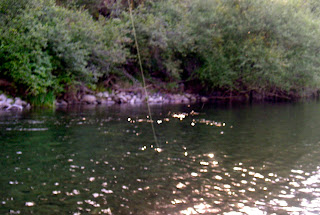 But the dream is never forgotten, only put aside and never out of reach: Where once the dream connected boys with the world of men, now it reconnects men with the spirit of boys.
But the dream is never forgotten, only put aside and never out of reach: Where once the dream connected boys with the world of men, now it reconnects men with the spirit of boys. John Thorn
It is a very warm, lazy Sunday. For the first day in nearly nine months, flows on my river are finally stabilizing below three thousand cfs. I stop momentarily at a fork in the trail, a spectator to the seemingly endless parade of inflatables sliding downstream past my elevated position.
I will, later as I write this, wonder why I didn't substantiate that which I have just described with a picture. But as soon as that thought occurs another one replaces it; if I feel the need to prove the validity of my statement there will be ample opportunities in the near future to do so. I should have known better than to be here on this Chamber-of-Commerce Sunday after a string of similarly warm, blue-sky days. And it's not like I can blame those who are using the river for recreational purposes other than wetting a line. It does run right through Spokane. It's close, it's cool, and it's free. About all I can do is silently curse those who have the liberty to be here and yet take such little pride in what I feel they are privileged to enjoy. Flashes of sunlight reflected from floating beer cans underline my frustration. I turn to the west. From as far upstream as I can see they float into view, strung out from bank to bank. A motley flotilla of tubes, rafts, and coolers. The sheer volume of traffic amazes me, and I stand, almost hypnotized, for much longer than I should.
Plans altered, I set out again, opting for my hidden place downstream where I know I will find solitude. The trail now takes me back into the thicket, the cacophony of shouts and merriment slowly, mercifully, fading.
A mile or so downstream there is a channel that hugs the hillside, carved over time into the terrain that carries the high water of spring. This channel, which is now dry, serves to provide me a faster, easier, and unless you know of it, more secretive route to my destination. It is refreshingly cool and quiet now as I make my way briskly through the sparse brush under the towering cottonwoods. Less than a stone's throw to my east the floating, inebriated masses are continuing on their way.
I wade gingerly on slippery rocks down and across a faster, permanent channel where in spring the now dry channel emptied its overflow. Fifty yards or so downstream from the junction is an old alder, stubbornly anchored in the swift currents, and because of its disposition in the current, an accumulation point for years of floating detritus. I have, over the years, come to love this old, defiant tree. It forms a perfect current break. A deep, slow run extends downstream for almost a hundred feet. And because of its proximity to the side of the steep hill climbing to the south from its edge, it seems to go basically unnoticed, or so I like to think.
And so while my river occupies herself, patiently but purposefully pushing the inflatable party downstream, I wade slowly, quietly, in relative solitude, stalking the fish whose noses are creating beautiful, expanding rings.
There are three sets of rings regularly occurring in the dying light of the late afternoon, and I sense that these fish feel very secure here. Out of sight, out of danger. But they are in a tight group dimpling the surface no more than six, maybe seven feet below the alder, whose overhanging branches pose a serious threat to a fly cast a little too boldly. So I will not have many chances. I never do here, in this place, but that's why I love it. No room for error.
The nearly forty foot upstream cast must be made sidearm in order to pass safely under the branches, and it must come in from an angle to keep the leader from being seen. I know from past experience here that if that is accomplished, there is most certainly a reward for the effort. The fly need not be a perfect replica of what is being sought, but it must be settled on the water above the uppermost ring to have a chance.
I false cast directly upstream so as not to alarm the feeders. Once my line length is sufficient, I drop the rod until I am casting parallel to the surface and angle it in the direction of the rings. The delivery is not perfect, but the fly turns over inches beneath the branches, settles and is drag free just long enough...
... for a projectile to suddenly break the surface, somersaulting while becoming totally airborne before splashing down tail first. My leader follows the flight, and I gently lift my rod. Surprise- surprise! I have said before and I underline it again; these are pound-for-pound the strongest, wildest rainbow I have ever hooked into anywhere.
By the time that nineteen inch buck had finally tired enough to bring him to hand, I was totally humbled. His beautiful coloration and fierce desire to get free won my admiration, and as he swam out of my hand, a tear from my eye fell on the water above his back.
I just stood there in that channel for the longest time, captured again by the moment in my time I had just experienced, thankful for all the hours, for all the trials, for all the chances to be able to do just this, while not too far away, out on my river, the party went on.
No comments:
Post a Comment